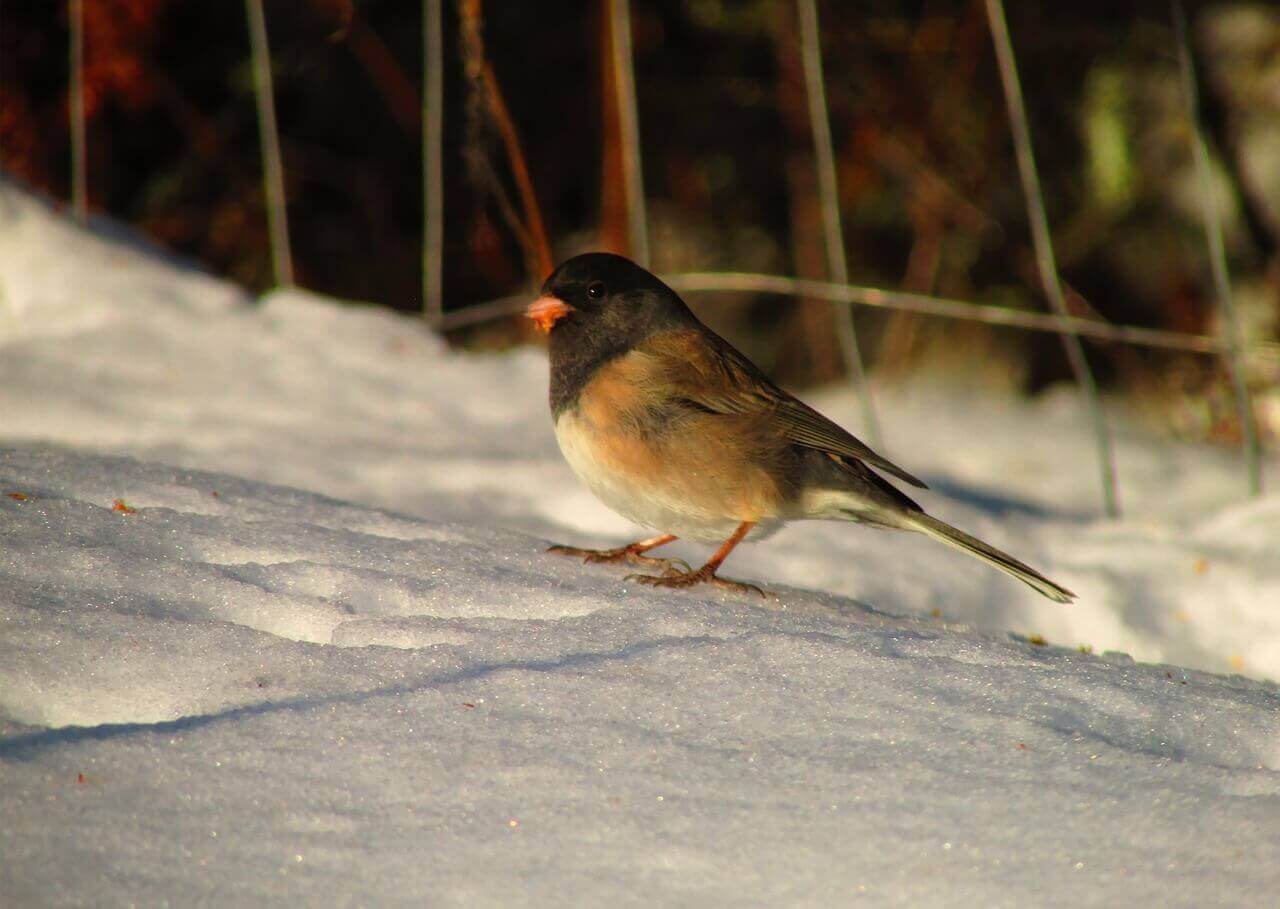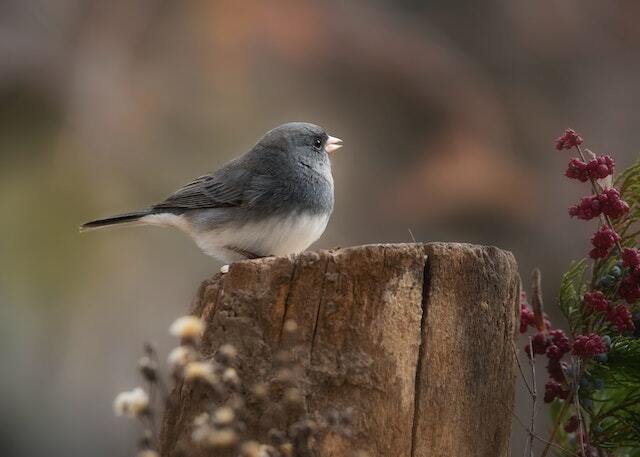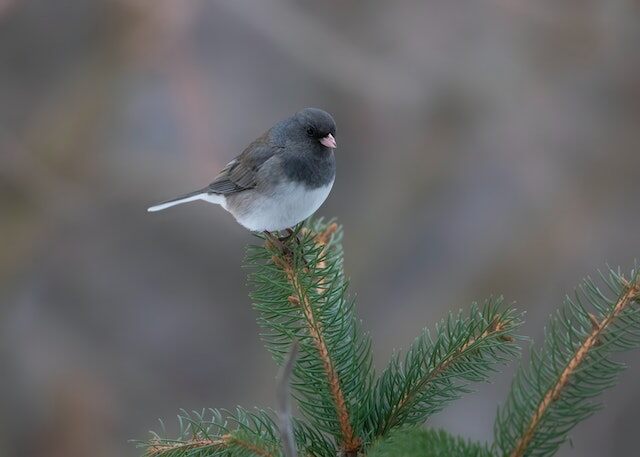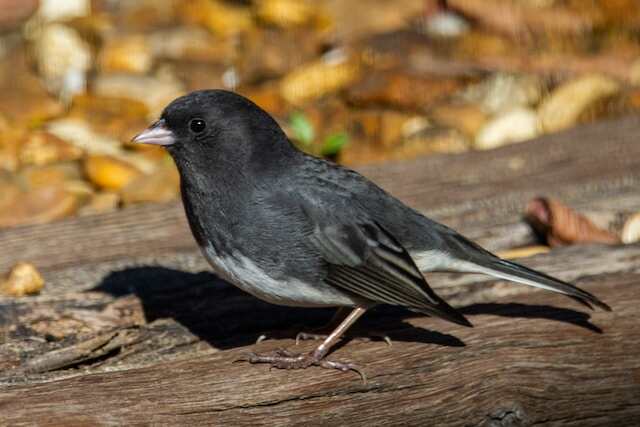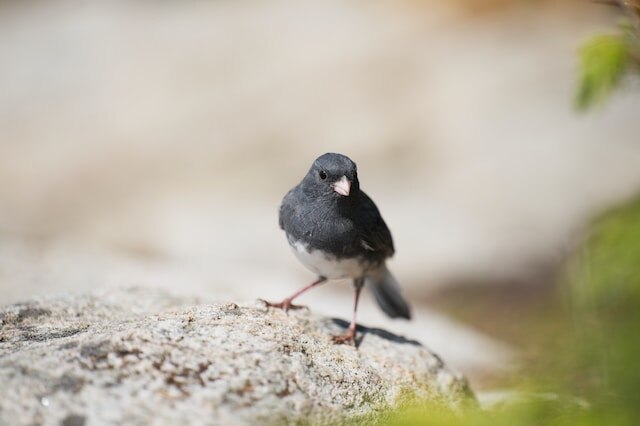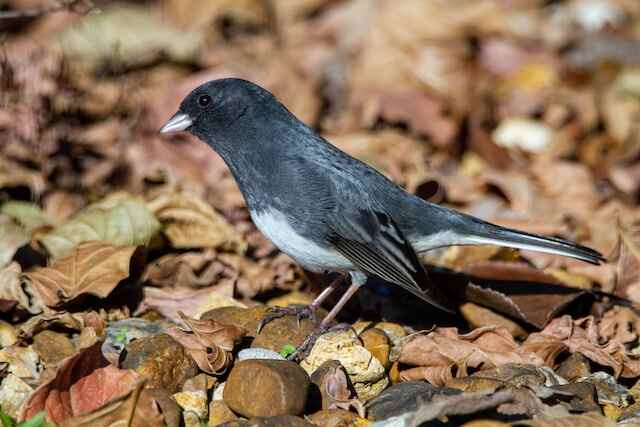The Dark-Eyed Junco, with its striking plumage and lively personality, is a favorite among bird enthusiasts. Found across North America, this charming bird captivates with its unique behaviors and adaptations. Dive into these fun facts to uncover the fascinating world of the Dark-Eyed Junco, from its diverse habitats to its intriguing migration patterns. Whether you’re a seasoned birder or just curious about wildlife, these insights will deepen your appreciation for this delightful species.
Table of Contents
- 1 Key Takeaways:
- 2 Fun Facts About Dark-eyed Juncos
- 3 Dark-eyed Junco Appearance and Characteristics
- 4 Dark-eyed Junco Behavior
- 5 Dark-eyed Junco Habitat
- 6 Dark-eyed Juncos Nesting Habits
- 7 Dark-eyed Juncos Migration Patterns
- 8 Dark-eyed Junco Vocalizations
- 9 Dark-eyed Junco Diet
- 10 Dark-eyed Junco Predators and Threats
- 11 Dark-eyed Junco Conservation Status
- 12 Dark-eyed Junco Interactions with Humans
- 13 Dark-eyed Junco Scientific Classification
- 14 Dark-eyed Junco Fun Facts Roundup
- 15 Conclusion
- 16 FAQs: Fun Facts About Dark-eyed Juncos
- 16.1 Are Dark-eyed Juncos found only in North America?
- 16.2 What are the characteristics of Dark-eyed Juncos?
- 16.3 What is the habitat of Dark-eyed Juncos?
- 16.4 How do Dark-eyed Juncos build their nests?
- 16.5 Do Dark-eyed Juncos migrate?
- 16.6 What do Dark-eyed Juncos eat?
- 16.7 What are the threats faced by Dark-eyed Juncos?
- 16.8 What is the conservation status of Dark-eyed Juncos?
- 16.9 How do Dark-eyed Juncos interact with humans?
- 16.10 What is the scientific classification of Dark-eyed Juncos?
- 16.11 What are some fun facts about Dark-eyed Juncos?
- 17 Author
Key Takeaways:
- Dark-eyed Juncos are prevalent throughout North America and are known for their unique appearance and behavior.
- They have distinct physical characteristics, including color variations and markings, and are adapted to different regions.
- Dark-eyed Juncos prefer ground-feeding and have unique foraging and nesting habits.
- They undertake long-distance migrations and have various vocalizations and dietary preferences.
- Despite facing predators and threats, Dark-eyed Juncos are abundant and have a widespread distribution.
| Attribute | Information |
|---|---|
| Scientific name | Junco hyemalis |
| Common name(s) | Dark-eyed junco, snowbird |
| Size | 5-6 inches in length |
| Weight | 0.5-1 ounce |
| Habitat | Forests, woodlands, and brushy areas |
| Range | North America |
| Diet | Primarily seeds, but also insects and spiders |
| Predators | Hawks, owls, and other birds of prey |
| Lifespan | Up to 11 years in the wild |
| Breeding | Monogamous, mate for life |
| Courtship behavior | Male puffs out chest and flicks tail feathers |
| Call | High-pitched “tinkling” sound |
| Conservation status | Least concern |
Fun Facts About Dark-eyed Juncos
The Dark-eyed Junco is a small songbird that is native to North America. These birds are known for their distinctive white belly and dark hooded head, which make them easy to spot in the wild.
They are also commonly referred to as “snowbirds” because they often migrate to lower elevations during the winter months. Dark-eyed juncos primarily eat seeds, but they will also eat insects and spiders.
They are monogamous and will mate for life, and they are known for their unique courtship behavior, which involves the male puffing out his chest and flicking his tail feathers.
These birds are a favorite among birdwatchers because they are easy to spot and have a wide range of color variations.
They are also important indicators of forest health and can serve as an early warning system for environmental problems.
Dark-eyed Junco Appearance and Characteristics
Dark-eyed Juncos are small, sparrow-like birds that are known for their distinctive plumage and markings. Typically measuring between 5 and 6 inches in length and weighing around 0.4-0.8 ounces, Dark-eyed Juncos are among the smallest birds in North America.
One of the most striking characteristics of Dark-eyed Juncos is their coloration, which varies according to geographical region. For instance, Dark-eyed Juncos in the eastern United States typically have a dark gray head, neck, and breast, with a rusty brown back and wings, while those in the western United States have a darker, slate gray head and back, and a more muted, brownish-gray breast.
Another distinctive feature of Dark-eyed Juncos is their characteristic white outer tail feathers, which are visible when the birds are in flight. This design is especially effective in enabling these birds to fly through dense vegetation and avoid predators.
Dark-eyed Juncos are also known for their adaptability in terms of their plumage, which changes slightly in response to different environmental conditions. For example, Dark-eyed Juncos in the northernmost parts of their range have a slightly longer bill and a thicker plumage to help them survive in colder temperatures.
Plumage Variations in Dark-eyed Juncos
| Geographical Region | Plumage Characteristics |
|---|---|
| Eastern United States | Dark gray head, neck, and breast, rusty brown back and wings |
| Western United States | Darker, slate gray head and back, muted, brownish-gray breast |
Despite their small size, Dark-eyed Juncos are known for their agility, versatility, and resilience, making them one of the most fascinating birds to observe in the wild.
Dark-eyed Junco Behavior
Dark-eyed Juncos are known for their unique and fascinating behavior, which makes them a popular subject of study among ornithologists and bird enthusiasts. Here are some fun facts about their behavior:
- Dark-eyed Juncos are primarily ground feeders, with a preference for seeds and insects. They often forage in mixed-species flocks, which allows them to increase their feeding efficiency and reduce the risk of predation.
- During courtship, male Dark-eyed Juncos perform a delightful, bouncing dance that involves fluffing up their feathers and spreading their tails to showcase their white outer feathers.
- Dark-eyed Juncos are highly social birds and often engage in group activities like dust bathing and sunning. They are also known to engage in playful behavior, such as chasing each other and performing acrobatic feats in mid-air.
- When threatened or alarmed, Dark-eyed Juncos emit a sharp “tick” call that alerts other birds in the vicinity.
- Dark-eyed Juncos are known for their adaptability, which allows them to thrive in a variety of habitats ranging from forests to suburban areas. They are also one of the few bird species that can tolerate high altitudes and cold temperatures.
Overall, the behavior of Dark-eyed Juncos is a testament to their resilience and adaptability in the face of changing environments.
Dark-eyed Junco Habitat
Dark-eyed Juncos have a wide range of preferred habitats, ranging from forests to open woodlands, and even suburban areas. They are common throughout North America and can be found in all 50 US states, as well as throughout Canada and Mexico.
Dark-eyed Juncos are highly adaptable and can be found at a wide range of elevations, from sea level to alpine forests. They are most commonly found at elevations between 2,500 and 10,000 feet, but can also be found at lower elevations in winter.
Within their preferred habitats, Dark-eyed Juncos typically favor areas with dense vegetation, such as brushy areas, thickets, and forest edges. They also prefer areas with ample cover for nesting and protection, such as brush piles, shrubs, and low-hanging branches.
In suburban areas, Dark-eyed Juncos can often be found in parks and gardens. They are attracted to bird feeders and will readily visit backyards for food and shelter.
Despite their adaptability, Dark-eyed Juncos may face habitat loss due to deforestation and development. Climate change may also impact their preferred habitats, as changing temperatures and rainfall patterns alter the composition of forest ecosystems. Conservation efforts aimed at preserving their habitats and migratory routes can help ensure their long-term survival.
Dark-eyed Juncos Nesting Habits
Dark-eyed Juncos are known for their unique nesting habits. They construct cup-shaped nests made of twigs, grass, and other materials on or near the ground. These nests are often concealed in dense vegetation, providing cover and protection for the vulnerable eggs and young.
Female Dark-eyed Juncos are responsible for building the nests, with males occasionally assisting by bringing materials. They typically lay 3-5 eggs per clutch, with an average incubation period of 12-13 days. Once hatched, both parents share in the duties of feeding and caring for the young.
Dark-eyed Juncos are known for their fidelity to their nesting sites. They often return to the same area year after year to breed, and may even reuse the same nest. In some cases, multiple generations of Juncos may use the same nest in subsequent years.
Interestingly, certain subspecies of Dark-eyed Juncos exhibit different nesting preferences. For example, the “gray-headed” subspecies prefers to build nests on high ledges or in tree cavities, while the “pink-sided” subspecies constructs nests in more open areas.
Dark-eyed Juncos Nesting Habits:
| Nesting Habits | Details |
|---|---|
| Nest construction | Cup-shaped nests made of twigs, grass, and other materials. |
| Nesting sites | On or near the ground, concealed in dense vegetation. |
| Egg laying | 3-5 eggs per clutch, with an average incubation period of 12-13 days. |
| Parental care | Both parents share in feeding and caring for the young. |
| Nesting site fidelity | Dark-eyed Juncos often return to the same nesting site year after year. |
Overall, the nesting habits of Dark-eyed Juncos demonstrate their adaptability to different environments, as well as their commitment to their young and their habitats.
Dark-eyed Juncos Migration Patterns
Dark-eyed Juncos are known for their extensive range that spans across North America, from Alaska to Mexico. They exhibit unique migration patterns, with different populations exhibiting varied strategies.
Some populations are completely migratory, traveling long distances to breed in the northern parts of North America and wintering in the southern parts, such as Mexico. Others, such as those in the Pacific Northwest, are partial migrants, with some birds remaining in their breeding territories throughout the year.
Factors Influencing Migration
Migration patterns of Dark-eyed Juncos are influenced by several factors, including food availability, temperature, and photoperiod. As winter approaches and food becomes scarce in their breeding territories, birds begin their migration to areas with more abundant resources.
The temperature also plays a significant role in dictating the timing of migration. In the northern parts of their range, temperatures begin to drop as winter approaches, necessitating a southward journey. Photoperiod, or the length of daylight, also influences Dark-eyed Juncos’ migration. As the days shorten, birds initiate their migratory journey to their wintering grounds.
Dark-eyed Junco Vocalizations
Dark-eyed Juncos are known for their varied vocalizations, which include a range of songs, calls, and even regional dialects. These vocalizations play an important role in communication, territorial defense, and mate attraction.
The male juncos are particularly vocal during the breeding season, producing a series of melodic songs, each consisting of several notes. These songs often include trills and whistles and can be heard from a distance.
In addition to their songs, Dark-eyed Juncos have a variety of calls, including a sharp “tick” and a buzzy “buzz.” These calls are used for alarm, contact, and territorial defense.
Interestingly, different populations of Dark-eyed Juncos have distinct regional dialects, with slight variations in their songs and calls depending on their location.Fun Fact: Some birdwatchers refer to the Dark-eyed Junco’s call as “the sound of winter” due to their prevalence during the colder months.
Dark-eyed Junco Diet
Dark-eyed Juncos have an omnivorous diet, which varies depending on their location and season. They primarily consume seeds, including those of grasses, weeds, and trees. Insects, berries, and small invertebrates also make up a significant portion of their diet.
Dark-eyed Juncos use a unique feeding technique called “hopping and pecking.” They hop rapidly on the ground, searching for food items, and peck at them with their sharp bills. They are also known to cling to trees and shrubs to feed on insects and berries.
Dark-eyed Juncos play an important role in seed dispersal, as they consume and distribute various plant seeds in their range. This helps to promote plant diversity and maintain healthy ecosystems.
Dark-eyed Junco Predators and Threats
Like all wildlife, Dark-eyed Juncos face a variety of natural and human-induced threats that affect their populations. Some of the common predators of Dark-eyed Juncos include various birds of prey, such as hawks and owls, as well as mammalian predators like domestic and feral cats, foxes, and weasels. These predators can pose a significant threat to both adult juncos and their young during breeding season.
However, the greatest challenge facing Dark-eyed Juncos today is habitat loss due to human activities, such as deforestation, urbanization, and agricultural expansion. As forests and other natural habitats are cleared for human use, the juncos lose critical nesting and foraging sites. Climate change also poses a threat to Dark-eyed Juncos, as it alters the availability of suitable habitats and food sources.
Despite these challenges, Dark-eyed Juncos have shown remarkable resilience in adapting to changing environments. They are able to nest and forage in a variety of habitats, from dense forests to suburban backyards, and are known for their ability to form mixed-species foraging flocks with other bird species.
Dark-eyed Junco Conservation Status
Dark-eyed Juncos are not currently considered threatened or endangered species. In fact, they are one of the most abundant and widespread birds in North America, with a population estimated to be in the tens of millions.
While they are not facing significant conservation concerns currently, the effects of climate change and habitat loss could impact their populations in the future. Additionally, their preference for dense vegetation in their nesting and foraging habitats could result in conflict with human development and land management practices.
Efforts have been made to protect Dark-eyed Junco habitats in national parks and conservation areas. Volunteer efforts to monitor and document Dark-eyed Junco populations have also helped to better understand their behavior and habitat needs.
Dark-eyed Junco Interactions with Humans
Dark-eyed Juncos are a common sight in backyards across North America, and their endearing nature has made them a favorite among birdwatchers. These charming birds are known for their curious and friendly behavior, often approaching humans in search of food.
Many people also enjoy watching Dark-eyed Juncos in their natural habitats, whether it’s in forests, woodlands, or suburban areas. Their distinctive plumage and cheerful songs make them a delight to observe.
Interestingly, Dark-eyed Juncos also play a significant role in folklore and Native American culture. In some traditions, they are believed to bring good luck, while in others, they are viewed as messengers of death.
Overall, Dark-eyed Juncos have a special place in the hearts of many nature lovers. Their interactions with humans are a testament to their adaptability and willingness to coexist with us.
Dark-eyed Junco Scientific Classification
The Dark-eyed Junco, or Junco hyemalis, belongs to the kingdom Animalia, phylum Chordata, class Aves, order Passeriformes, family Emberizidae, genus Junco, and species hyemalis. There are several recognized subspecies of Dark-eyed Juncos, including the “Slate-colored,” “Oregon,” “Pink-sided,” “Gray-headed,” and “White-winged” varieties.
Dark-eyed Junco Fun Facts Roundup
As we wrap up our exploration of Dark-eyed Juncos, let’s summarize some of the most interesting and fun facts about these delightful birds:
- Dark-eyed Juncos are one of the most widespread and abundant bird species in North America.
- There are several subspecies of Dark-eyed Juncos, varying in appearance and distribution.
- Dark-eyed Juncos have distinct regional dialects in their songs and calls.
- They prefer to nest on or near the ground, building cup-shaped nests concealed by vegetation.
- Dark-eyed Juncos are adaptable to different habitats, from forests to suburban areas.
- They form mixed-species foraging flocks during the winter months.
- Dark-eyed Juncos undertake long-distance migrations, with some traveling up to 2,600 miles each way.
- They are omnivorous, feeding on seeds, insects, berries, and small invertebrates.
- Dark-eyed Juncos play an important role in seed dispersal, aiding in forest regeneration.
- They face natural predators such as birds of prey and mammalian predators, as well as human-induced threats like habitat loss and climate change.
These are just a handful of the many fascinating aspects of Dark-eyed Juncos. Next time you spot one, take a moment to appreciate these charming birds and all they have to offer.
Conclusion
Dark-eyed Juncos are truly nature’s delight, offering a plethora of fascinating and fun facts to discover. From their distinct physical characteristics to their unique behaviors and vocalizations, these birds never fail to captivate birdwatchers and nature enthusiasts alike.
As we’ve learned throughout this article, Dark-eyed Juncos are incredibly adaptable birds, able to thrive in a variety of habitats and environments. Their resilience in the face of natural predators and human-induced threats is a testament to their remarkable ability to adapt and survive.
Despite their widespread distribution and abundance, it’s important to continue to appreciate and protect these delightful birds. Conservation efforts aimed at preserving their habitats and promoting their long-term survival are crucial in ensuring their continued presence in our environments.
So the next time you’re out in nature, keep an eye out for these charming birds and appreciate all the fun facts and characteristics they have to offer. Fun facts about Dark-eyed Juncos are not just educational, but they also help us appreciate the beauty of nature that surrounds us.
FAQs: Fun Facts About Dark-eyed Juncos
Are Dark-eyed Juncos found only in North America?
Yes, Dark-eyed Juncos are primarily found in North America.
What are the characteristics of Dark-eyed Juncos?
Dark-eyed Juncos are small, migratory birds with various color variations and distinct markings.
What is the habitat of Dark-eyed Juncos?
Dark-eyed Juncos prefer habitats such as forests, open woodlands, and suburban areas.
How do Dark-eyed Juncos build their nests?
Dark-eyed Juncos build cup-shaped nests on or near the ground, often in concealed locations.
Do Dark-eyed Juncos migrate?
Yes, Dark-eyed Juncos undertake long-distance migrations and have varying migration patterns.
What do Dark-eyed Juncos eat?
Dark-eyed Juncos have an omnivorous diet, consuming seeds, insects, berries, and small invertebrates.
What are the threats faced by Dark-eyed Juncos?
Dark-eyed Juncos face threats from predators, habitat loss, and climate change.
What is the conservation status of Dark-eyed Juncos?
Dark-eyed Juncos are abundant and have a widespread distribution, but conservation efforts are still important to protect their habitats.
How do Dark-eyed Juncos interact with humans?
Dark-eyed Juncos can be found in backyards and are popular among birdwatchers.
What is the scientific classification of Dark-eyed Juncos?
Dark-eyed Juncos belong to the animal kingdom, chordata phylum, aves class, passeriformes order, emberizidae family, junco genus, and hyemalis species.
What are some fun facts about Dark-eyed Juncos?
Dark-eyed Juncos have distinct regional dialects in their vocalizations and are important seed dispersers.

